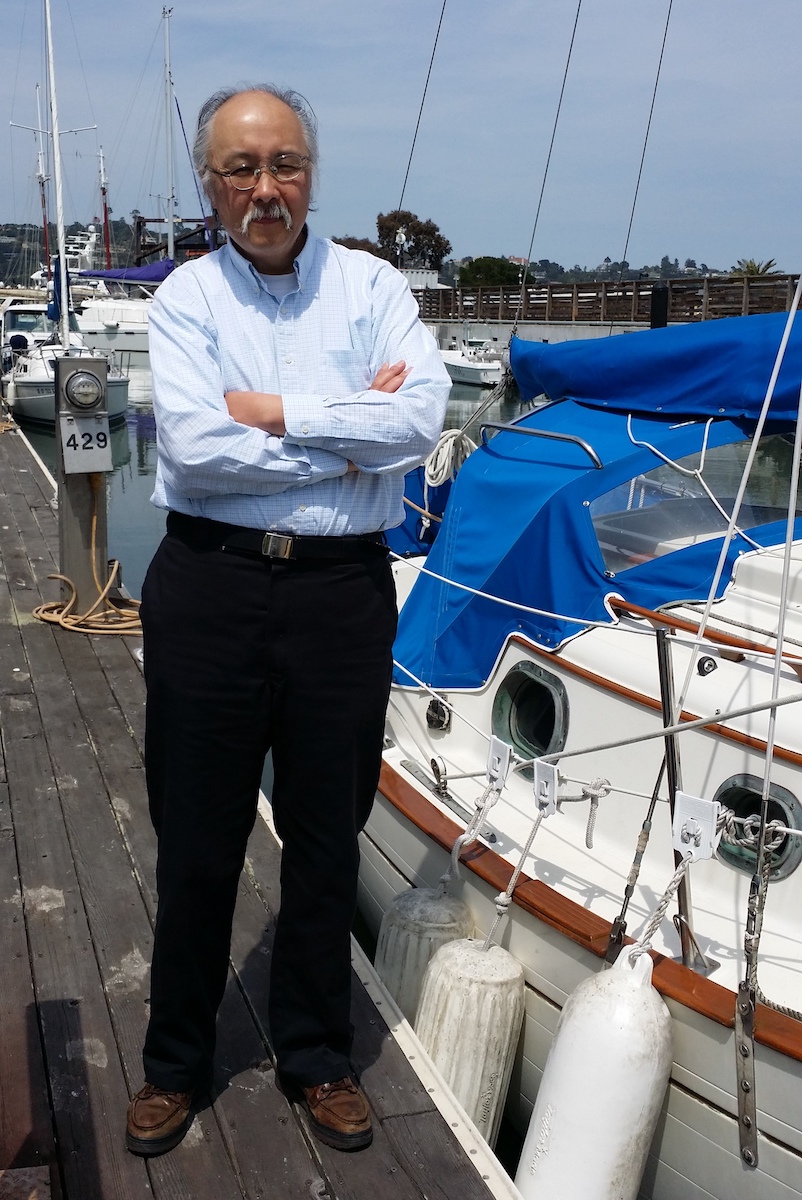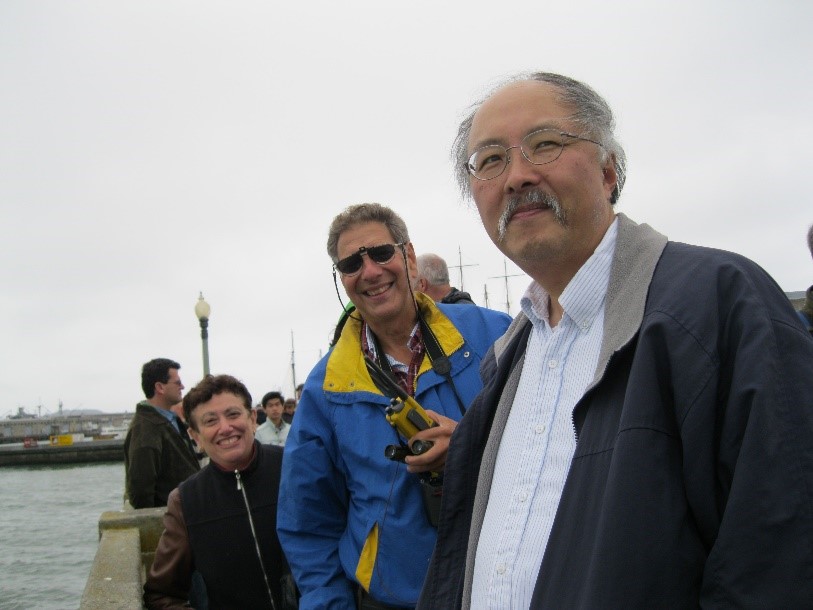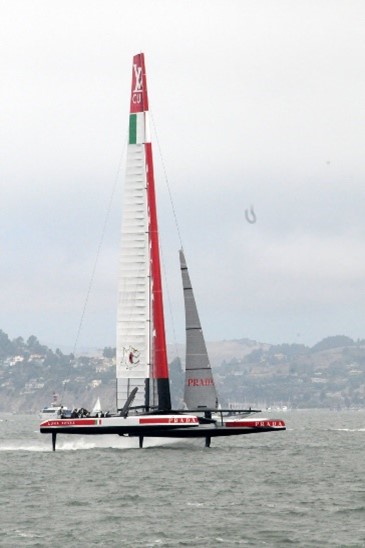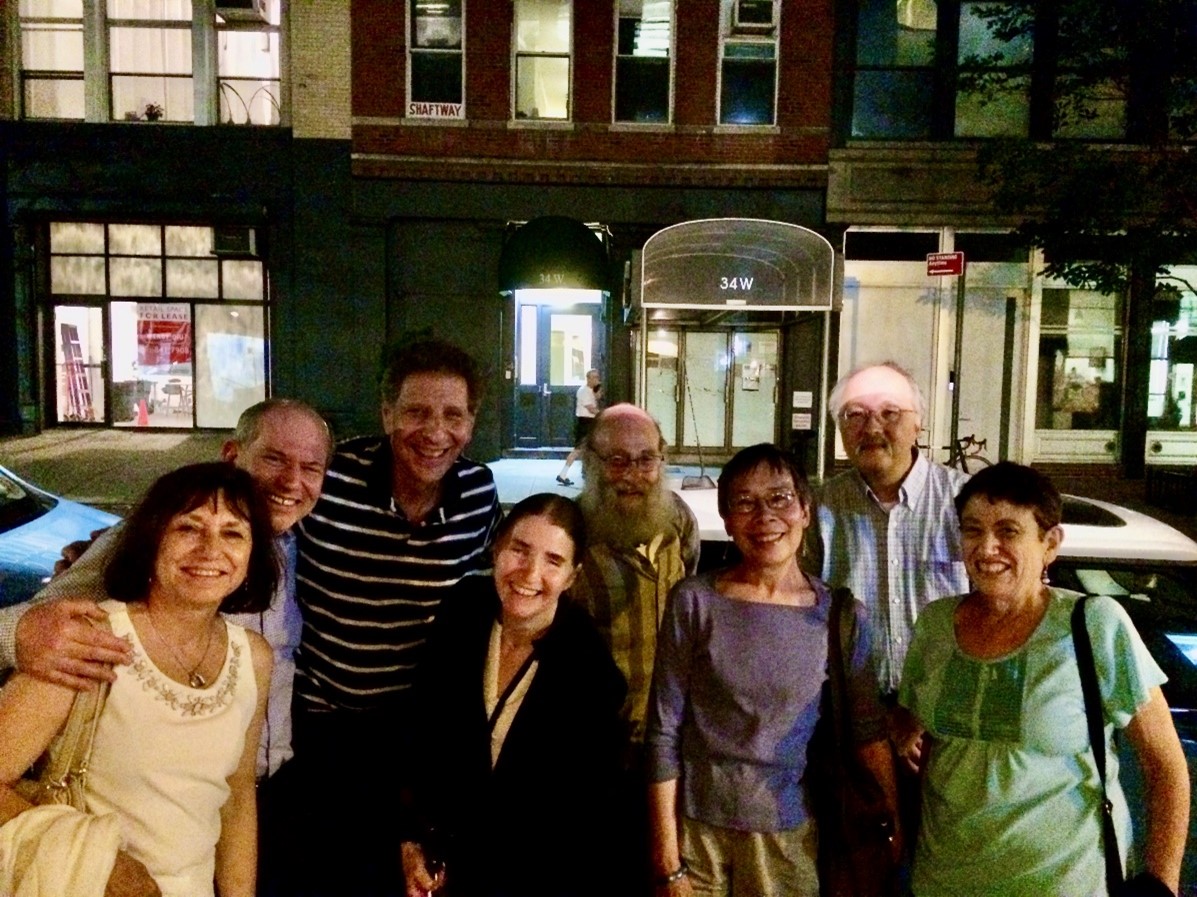
Hoover at the San Francisco marina in 2019.

Our community is deeply saddened with the passing of Hoover R. Chan in the early morning of April 30, 2025, at the age of 69. For three decades Hoover was of course known to us for providing a cornerstone of the vision research community through his stewardship of the Color and Vision Network (CVNet). This vital communication platform, which he personally funded and maintained since the mid 1990s, has been a primary channel through which vision scientists worldwide have shared research resources, scientific advancements, scholarly discussions, conference announcements, and job opportunities. Beyond this extraordinary service that united researchers across continents, Dr. Chan made significant contributions to vision science through his research and collaborations.
Beginning with a B.A. in Mathematics from Reed College, he earned his Ph.D. at U.C. Berkeley, followed by post-doctoral fellowships in color vision at Brooklyn College of the City University of New York with Israel Abramov and in spatial vision at the Smith-Kettlewell Eye Research Institute with Christopher Tyler. He then turned his skills to becoming an IT specialist for a group of schools in the San Francisco area, and hosting their local area network. More recently, he held the position of Full Professional Researcher in the Department of Ophthalmology at the University of California, San Francisco Medical Center, where he pursued research in a wide range of non-invasive electrophysiological studies of human vision and their clinical applications. On retiring, he rejoined Smith-Kettlewell in an advisory capacity.
Hoover is the current recipient of the 25th Anniversary Lifetime Service Award from the Vision Sciences Society in recognition of his four decades dedicated service in maintaining CVnet, which he funded from his own resources over this entire period. The many messages of appreciation that have come in following the brief announcement of his death attest to how much this channel of communication means to the members of the vision community.
A longstanding member of ARVO, OSA, and ISCEV, Hoover also participated in a wide variety of educational and public service organizations. He generously contributed his extensive technical skills, advice, and enthusiasm to the CIE Technical Committees on standards in vision science. Further, he founded and/or taught English as a Second Language (ESL) and Citizenship classes at the Chinese Progressive Association groups in New York City and San Francisco, and organized and coordinated health fairs in the San Francisco Chinatown /North Beach areas.
Hoover was an experienced yachtsman, caring for a succession of five different craft based in San Francisco Bay, on which he would entertain his friends and associates. He also taught boating safety classes for the US Power Squadron. His many friends and colleagues will always remember him for his unbounded curiosity, keen intellect, generosity, social awareness, and the calm, quiet strength that he maintained in his final days. He is survived by his wife, Debra Liu and his mother, Asako Chan. Donations should specify which of the institutions he fostered should be the recipient.
If you have memories, anecdotes, vignettes about Hoover to share, David Grosof is collecting them to compile and post for our community here. Please email them, with "cvnet" in the subject line, to grosof+cvnet@gmail.com. His life will be celebrated in a remembrance at the Smith-Kettlewell Eye Research Institute on June 18th.
Frans Verstraten wrote an editorial about Hoover in the journal Perception which you can read here.
I have one tiny story about Hoover that has a certain glow as I remember it. Unknown to me then was the fact that Hoover was either a math or physics major at Reed College. [Ed.: math] Legend was that only very brainy kids went to Reed, much more so than the Ivy league or Stanford. Sometime during the 1980s Jerry Silverman was my research assistant and a friend of Hoover's. All of the sudden Jerry and Hoover were conferring nearby. They were at a table with many pieces of paper with lists of handwritten numbers strewn about. What were they doing? After what seemed a full day, they came to me with satisfaction. They had figured out in exacting detail how the Fast Fourier Transform algorithm actually worked. While Hoover was known for his great service to the Vision Sciences Community, also admirable to me was his genuine interest in really understanding things.
Issy Abramov and I had the good fortune to work with Hoover when he came as a Post Doc to Issy’s lab at Brooklyn College from 1988 to 1990. Hoover quickly became involved in all of the work in the lab.He was central to our work showing, in a series of seven papers, that hue scaling could be used as a rapid accurate way to measure many aspects of color vision and in developing a color space called a uniform appearance diagram (UAD).From this diagram color functions, from wavelength discrimination to similarity ratings, could be derived, taking a fraction of the time it would take to do the same measurements with older psychophysical measures. And with Hoover, we also used this method to study color vision as a function of stimulus size across the visual field. Hoover’s presence in the lab made this a particularly spirited and productive time in the Brooklyn College Vision Lab.
As with so many people who interacted with Hoover, we became lifelong friends. In addition to our scientific collaborations, we shared a passion for sailing. We had many discussions comparing East Coast with West Coast sailing though we each sailed only once on the other’s boat. One very fond memory was visiting Hoover and Debra in San Francisco to watch the challenger series for the 2013 America’s Cup race. We stood along the shore of San Francisco Bay as these giant catamarans flew by up on their foils and near to the shore at astounding speeds. These photos show Hoover, my wife Judi and me looking out (photo by Debra) at Luna Rosa up on foils. As monohull sailors we would argue about whether these giant cats were really sailboats or some other kind of winged creature.


No memory of Hoover would be complete without some mention of his love of food and wine enjoyed with his friends. On their yearly visit in the summer to NYC we would find a wonderful restaurant and enjoy the food and the wine and the company. This is a photo of Hoover and Debra with Vance and Jane Zemon, Issy Abramov and Elaine Hall, and Jim and Judi Gordon just outside of Da Andrea in the West Village in 2014.

I never really worked with Hoover, but he was a great help in my setting up another mailing list for a different group. And in making sure that things that went out on cvnet from me were properly formatted. I hardly knew him, but every one of my interactions with him was really pleasant and useful. I really admire people who contribute to the community, as I’ve tried to do in a number of other respects. It’s generally fairly thankless, and so it’s very nice to see people giving thanks, if only now. With best wishes, Michael
Memories of working with Hoover Chan
When I moved to the Department of Ophthalmology at UCSF from the UCL Institute of Ophthalmology I soon recognized that there was a need to establish a visual electrophysiology service for infants and children. Once we had identified the funding, the main issue was to recruit a post-doctoral visual scientist to develop the service. We were very fortunate that Hoover, who had a strong background in visual electrophysiology and psychophysics, applied for the post. I wanted to develop similar techniques to what was used in London to perform as many tests as possible in awake children, avoiding the need for general anesthesia. Hoover spent several weeks in London working with Graham Holder at Moorfields Eye Hospital and Dorothy Thompson at Great Ormond Street Children’s Hospital. On his return to San Francisco, he quickly set up a similar high quality service. This was underpinned by his strong scientific expertise but importantly by his friendly and reassuring personality. He was very good at calming anxious children. He was also very kind and patient with the orthoptic staff who were helping him with testing.
Alongside the clinical service Hoover was a key member of the team involved in the ocular gene therapy trials at UCSF –his expertise in electrophysiology and psychophysics ensuring that visual function testing of subjects in the trials was of a high standard. Again, patients appreciated his kindness and professionalism.
Hoover was a careful scientist who in his move to a clinical setting made a great impact on the care of children in San Francisco. Hoover will be remembered by his clinical colleagues for his enthusiasm, kindness and generosity.
Tony Moore
Emeritus Professor of Ophthalmology
UCSF School of Medicine
From Lauren Barghout comes memories of Hoover as teacher, mentor, colleague and friend:
Hoover had the gentle strength of scientific rigor when I met him, myself fresh from undergraduate work on the physics of magnetic materials and mathematical complexity. I was a new research assistant in Christopher Tyler's Lab in computational psychophysics at Smith-Kettlewell. Hoover, in the lab downstairs kept his door open. I'd pepper him with questions in physics terminology, and he'd help me reformulate my questions into photometric units and the mode of inquiry of human vision science. His mentoring continued through graduated school and even into the start-up world of the second version of the world wide web, called Web 2.0 at the time. My first patent application used a set of fuzzy logic color-constancy operations inspired by Hoover. When I had asked him for advice on handling color, he pointed out to me that color constancy and the perception of shadows co-existed at the same point in space. Hoover also suggested I repurpose my labs (as a teaching assistant for the Karen DeValois Color Vision Class at U.C. Berkeley) into calibrating the code for my start-up company tuned to my own color perception. This Paravue/Flashfoto automated image segmentation worked because of its unique way of handling color constancy. Hoover's guidance is what lay behind the algorithms handling color constancy. Many other heavy lifters helped design those algorithms, but Hoover's rigor as a vision scientist and his involvement in the Web2.0 start-up world contributed a big lift. I'll miss him as a friend, a scientist and a community builder.To all who didn’t know him in person: He was just as lovely a human being as everyone says. My superficial friendship over decades with him became deeper when he ≈10 yrs ago went into human visual electrophysiology (ISCEV.org stuff) and we discussed techniques in detail. At one ISCEV dinner I also had the pleasure to meet his wife. Quite recently we had an exchange about “strictness” when running a mailing list. He had his share of evil trolls there…
I’m sure his award, deeply deserved (thank you whoever you are who worked towards it!) will have meant really very much to him, just in time (I hope).
A grave loss of him as a person and the long-time tireless service he performed for all of us.
1. Hoover and I did our PhD work in sibling labs at University of California, Berkeley: Hoover in Karen De Valois’ lab and I in Russell De Valois’. My strongest memories of Hoover from that time say more about me than he: he was the only one ever to appear in Russ’ lab before 7 a.m. on mornings after I had stayed up all night doing extracellular single-unit cortical neurophysiology experiments. The scarcity of parking near campus is what drove him, so to speak, to arrive at an hour unholy to a night owl. Entering the basement lab, no doubt alerted to my experiment by the amplified noise of field potentials or the staccato single unit – and the fragrant odors of fellow primates, human and non-human alike – Hoover appeared to this perception scientist as both a serious, calm, genially humored, neatly dressed peer and also an apparition to mark the morning after the long night of isolation and experimenter’s sensory deprivation, a representative from the everyday world of normal sleep rhythms. As the former, his superior understanding of the lab minicomputer (with a whopping 64K of memory) was a great help when disasters struck, when sluggish backups stalled and daisy wheel printers jammed.
2. We got to know each other better, though, when we were 3,000 miles away in New York City for our post-docs in 1989 and the early 90s. Hoover was working with Israel Abramov and James Gordon at Brooklyn College, while I was at New York University, in lower Manhattan, with Bob Shapley. I guessed that Hoover was lonesome, because his wife Debra remained in San Francisco. NYC was particularly gritty and crime-ridden in the late 1980s and early 1990s, and I knew Hoover had never lived on the east coast before, while I had grown up in Manhattan and all my family was nearby. I was really impressed when he let slip that he had been doing some community organizing among the Chinese immigrants in the city: aha! You can take the man away from (the famously progressive, forward-thinking) Reed College, but you can't take the Reed from the man, I thought to myself.
One glorious weekend day stands out from that time. I was keen to see the comedy movie "U.H.F." the film debut of rock music parodist and prodigy Weird Al Yankovic. I rounded up my girlfriend, my father, and Hoover to join me at a lower Manhattan theater for an afternoon screening. The audience for this super-silly movie was great: the full potential of the ludicrous was realized. We staggered out of the theater almost high from comedy. My father seemed fully recovered from his stroke three years earlier and was in happy, fine form. He grandly took us out to dinner and we all succeeded in keeping our spirits jolly for hours after the movie, just hanging out, eating and talking and walking around lower Manhattan. Thirty years later, when my father died following a long decline, Hoover was the bearer of the good memory and went out of his way to tell me what a pleasure it had been for him to get to know my father that day. I could hear in his voice -- after 30 years! -- how much it could mean to really throw oneself in 'fun' and have someone shine his charm fully. In complimenting my father, in shining a light on a rainbow sparkle in memory’s wreckage, Hoover's kindness was and is a gift to me.
A lot of our interactions in NYC ended up being by email, however. We were both on Unix workstations at our labs, and it was clear Hoover was way smarter and hipper about pre-Web Internet data and code commons’s than anyone else I knew. While I attended the monthly NY Amateur Computer Club meeting, read Byte Magazine, and listened to two computing shows on WBAI radio, Hoover was the one from whom I first learned about the big Simtel shareware repository and first heard the word 'surf' to describe going from one internet site to another site. (Yes, the term was in use before the first World Wide Web browser). Hoover taught me to use Unix talk to chat with him *live* and of course we both speculated about how developments in computers would help us all do vision experiments faster, cheaper, smarter. It was only belatedly that I realized that "the well" of which he occasionally spoke and in which he participated was *the* WELL, the mothership of online innovation, the granddaddy of online communities, the Whole Earth 'Lectronic Link, created by Stewart Brand and Larry Brilliant in 1985.
3. By late 1992, Hoover had returned to San Francisco to work at Smith-Kettlewell, where I think he helped me get an invitation to talk about my research. He offered to take me out on his small sailboat on San Francisco Bay a day or so before the talk. I truly knew nothing about sailing: I had only been on ferries and one power boat. Out we went on a sunny December early afternoon, into a gentle breeze. Then the breeze stops. As in zero. The sun is shining and I'm blithely unconcerned. But there is a tide, you know? It's going out and we're slowly, slowly, being pulled closer to the San Francisco Bay's channel to the rough Pacific Ocean at the Golden Gate. Hoover was, by comparison with the high-strung, talkative, often neurotic NYU vision scientists with whom I was then working, who could get worked up discussing a sub-optimal parking space or taxicab routing choice, a serious, most-words-are-weighed-thoughtfully, somewhat laconic, even droll, person. That is what you would want in a captain, eh? Slowly, slowly, his concern rising after about 40 minutes of dead calm drift, he lets me know that the closer we get to the Gate and the harder it is to control the boat without any wind at all, the, um, worse it will be for both of us, so let's hope for wind and that we don't yet have to call for help. "Can you paddle a bit, David?" (He was one of only a couple of people whom I didn't mind calling me 'Dave', so it seemed more serious when he didn't.) A couple of hours of non-panicked paddling ensued, as the sun moved west -- and the tide, too. So we managed to stay in place instead of heading off … toward.Japan. Finally, the wind picked up. Hoover's body and voice relaxed: he was back in control of the boat, and we made our way back to safety.
4. After I moved back to San Francisco in 2001, it was feasible to see Hoover socially fairly regularly. Most of the time we met at his boat, a fine-looking yacht that was larger than the little boat we'd sailed in years earlier. We hung out on his boat at a beautiful marina, with a view of the Golden Gate Bridge, had a beer or a fancy coffee, and just talked.
One time Hoover was convinced that the coffee made in a particular fancy cafe (that we both liked) had a discernible vanilla flavor that was perhaps added in an undisclosed and likely suspect manner. This was a puzzle to Hoover because when this coffee was brewed at home with the same beans, with the same pour-over brewing method, same filter paper, same grind coarseness, etc., there was no such suspect flavor. I think he brought to his boat a thermos of home-made, which lacked vanilla nuance, and we then walked along the spectacular waterfront to the café and ordered the coffee. I agreed with him in detecting these vanilla notes. Like true sensory psychologists and systems thinkers, we entertained different hypotheses (traces of vanilla-ish heavy cream used heavily in the cafe, for example; traces of other beans in the grinder; different water). And yet -- the mystery endured. Though cracking the mechanistic explanation for our sensory experience was unsolved, hanging out there was a happy place for a Sunday afternoon in San Francisco, with the ocean breeze snapping up to wind by afternoon's end, the clouds rushing past us overhead, the procession of tourists just outside the marina, the wind surfers and small racing sailboats on the bay. "Want another beer, Dave?" "Sure, Hoover, thanks."